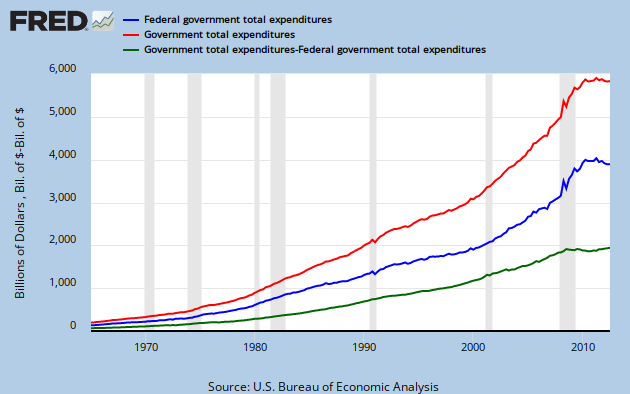How many times have you heard Boehner, McConnell, Ryan or one of the legion of right-wing talking heads say, "
We don't have a revenue problem, we have a spending problem?" I refuted that lie repeatedly in
this AB post and at the included links. But this is one of those zombie ideas that simply will not stay in the grave.
Therefore, some prominent voices have found it necessary to sing out again against the lie. I will add my humble quavery baritone to the chorus.
Here in Graph 1 is
Kevin Drum demonstrating how Real Government Expenditures per Capita have changed under the last three presidents.
What we have isn't a spending problem. That's under control. What we have is a problem with Republicans not wanting to pay the bills they themselves were largely responsible for running up.
Graph 1, Real Government Expenditures per Capita
By using real [inflation adjusted] and per capita numbers, Drum has introduced a couple of denominators. Real expenses per cap is a rational way to display the data, but not the only way. So lest someone cry out about that ol' devil denominator, let's have a different look.
Via
Paul Krugman we get Graph 2 and Graph 3, from FRED, showing total Government expenditures and Federal Government expenditures, respectively, on log scales.
Graph 2. Government Total Expenditures
Graph 3, Federal Government Total Expenditures
Yes, you can argue that spending was growing too fast under Bush,
although it’s funny how few deficit scolds saw fit to mention that at
the time. Or you can say that you just want less spending, although as
always people who say this tend to be short on specifics. But the
narrative that says that spending has surged under Obama is just wrong –
what we’ve actually seen is a slowdown at exactly the time when, for
macroeconomic reasons, we should have been spending more.
Remember, a log scale represents constant growth as a straight line, and zero growth as a horizontal line. So, in pure dollar numbers, spending hasn't quite declined, but it has stagnated to almost zero growth. Hence Drum's decline in inflation adjusted, per capita terms.
In Graph 4, we get one more longer range look, using Krugman's data series, this time on a linear scale. Also presented is the difference between the two, which is the amount of spending by state and local governments.
Graph 4, Government Spending at Different Levels
The red line is total spending at all levels of governemnt, the blue line is federal only, and the green line is the difference, state and local spending. Note that the green line flattens early in the recession
To bring things full circle, Graph 5 shows Federal Government current receipts. Look at this and tell me we don't have a revenue problem.
Graph 5, Federal Government Current Receipts
To drive this point home, Graph 6 shows Federal Receipts as a fraction of GDP. The purpose of the ratio is to provide context, using GDP as a proxy for the size of the economy.
Graph 6, Federal Receipts as a fraction of GDP
As you can see, revenues/GDP are in a historically low range.
Conclusions:
- Federal spending is flat in nominal dollar terms.
- Federal spending is declining when adjusted for inflation and population growth.
- Federal revenues are far below trend lines based on any historical reference you chose.
- Federal revenues as a fraction of GDP are historically low.
- The Republican claim that we have a spending problem not a revenue problem is simply a lie, on both counts.
- Disproportional spending growth has only occurred under two presidents: Republicans Ronald Reagan and George W. Bush.
Why do Republicans lie?
The truth is hostile to their agenda.
PK Explains.






![[Most Recent Quotes from www.kitco.com]](http://www.kitconet.com/charts/metals/gold/tny_au_xx_usoz_4.gif)


